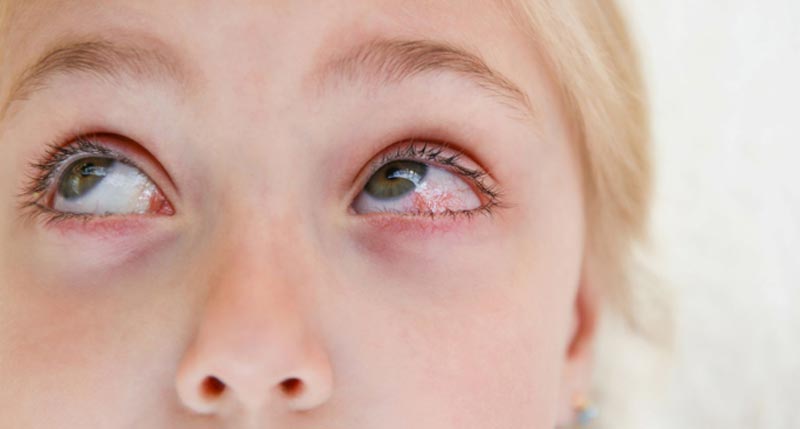In the U.S. alone, students miss an average of 3 million school days a year due to symptoms of conjunctivitis or “pink eye” as it is commonly known.
Pink eye is highly contagious and can spread rapidly in areas of close contact, such as schools, daycares, and athletic facilities. This is due in part to shared use of digital devices, books, toys, athletic equipment, and restrooms where kids touch door knobs, bathroom faucets, and toilet handles. There are several contagious and non-contagious ways to contract conjunctivitis. Below are some important facts to remember about pink eye – its causes, symptoms, how to avoid it, and when to contact your optometrist.
Common Causes and Symptoms of Pink Eye
There are four common causes of pink eye:
- A number of viruses, including adenoviruses, can result in large outbreaks of pink eye. These viruses are very contagious.
- Pink eye can be caused by numerous types of bacteria that spread very easily. We see bacterial conjunctivitis more often in kids than adults. It is highly contagious as soon as symptoms appear and for as long as the eye is producing discharge. We see it more frequently from December through April.
- This type can occur year-round and is not contagious. We see it seasonally (when pollen counts are high) in individuals who have other allergic conditions such as hay fever, eczema and asthma.
- This type of pink eye results from exposure to pollen, smoke, dust, fumes or chemicals and is not contagious. It can also occur when contact lenses are not properly cleaned or are worn longer than recommended.
Symptoms of pink eye can include:
- Red or pink coloration in the whites of the eye.
- Increased tear production
- Crusting of eyelashes or lids, particularly in the morning — sometimes accompanied by pus, mucus, or watery secretions.
- Swelling of the eyelids or the white part of the eye.
- Irritation, burning, itching, or an urge to rub the eye. Also, a feeling that “there is something in my eye” like sand or a grittiness.
How to Avoid Contracting Pink Eye
Practice good “eye hygiene” to avoid contracting pink eye. Implement the following tips in your household to maintain good eye health in every member of your family — school age and adult!
- Soap and water are your family’s best and easiest protection in preventing the spread of any communicable condition — especially pink eye. Encourage family members to wash hands frequently using soap and warm water as a matter of habit. It’s even more important to hand wash when someone in your household has been exposed to pink eye.
- If someone in your family has conjunctivitis, remind them that hand washing is especially important before and after cleaning the affected eye. This minimizes the chance of re-infection and reduces the possibility of infecting a family member.
- Let your student and family members choose a special towel and washcloth just for their use. Assign a color or pattern to each family member in order to keep everyone using their own towel and cloth and avoid cross-contamination.
- If you have young children, “lend them a hand” with hand washing to ensure a thorough job. It also gives you the opportunity to remind them to use their designated hand towel to wipe their hands or face.
- Wash towels and linens in hot water to decrease bacterial or viral growth. This includes pillow cases and every towel that comes in contact with the face and hands.
- It’s always smart to keep paper towels and boxes of tissues handy. Just give them a toss after wiping a “runny eye.” Remind your family that they do need to wash their hands after using tissues and paper towels.
- Stop wearing contact lenses while you have pink eye symptoms. Follow your optometrist’s instructions on cleaning, storing, or replacing contacts, and when it’s appropriate to resume wearing them.
- Do not use swimming pools when you have pink eye!
When to Contact Your Optometrist About Pink Eye
Contact your optometrist if your child has conjunctivitis and is experiencing any of these symptoms:
- Blurred vision that does not clear after cleaning discharge from the eye(s)
- Pain in the eye(s)
- Intense redness in the eye(s)
- Symptoms that worsen or don’t improve, especially after 24 hours of antibiotic use if the conjunctivitis has been diagnosed as bacterial
- A weakened immune system —such as HIV infection, cancer treatment, or other medical conditions or treatments that can affect the body’s ability to fight infection
- Pre-existing eye conditions
Your optometrist will determine the best treatment option for your student’s pink eye. The good news is that in most cases, the infection will clear without any complications within two weeks!

